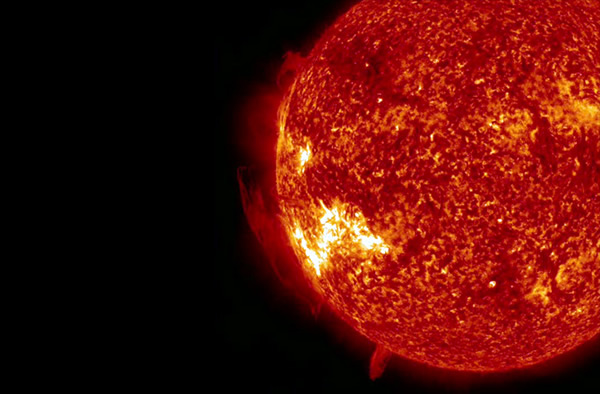The Sun -- An Observer's Guide
In this stunning view from NASA's orbiting Solar Dynamics Observatory (SDO), three large prominences hang over the solar limb for over 36 hours from June 16-17, 2013.
As someone who lives in the UK, views of the sun are somewhat few and far between. It has been fascinating to watch the slow increase in solar activity over recent years, when the typically cloudy skies have allowed me a sneaky peak.
But to see this increase in activity -- the sun is currently at "solar maximum" of its 11-year cycle -- you don't need a telescope to get an idea that things have been picking up. The steady increase in frequency of aurora displays is symptomatic of this period of intensified space weather, which is driven by solar activity.
But if you want to get up close and personal with our nearest star to see its current cycle peak, then here are some great techniques you can use.
SAFETY WARNING: Never look at the Sun directly either with or without optical aid. This can, and often does, lead to permanent eye damage. I once measured the temperature of solar radiation coming out of the eyepiece of an unfiltered telescope and in the brief moment of the experiment, the temperature of the eyepiece hit nearly 400 degrees -- NEVER try this at home. You do not want that solar energy going into your eye!
Solar Projection
This is probably the easiest of techniques, but also one that requires great caution.
Cut a circular hole no more than 50 millimeters (2 inches) wide in a piece of card large enough to completely cover the front end of your telescope or binoculars. Fix this securely to the front of the telescope with lots of good quality tape so that it cannot fall off.
The card will act as a mask to effectively make the aperture of your telescope much smaller and restrict the amount of solar radiation entering the system.
Make sure you have any finder telescopes covered up so sunlight cannot enter them and use the shadow of the telescope/binoculars on the ground line up with the sun. This will take a little practice but getting the shadow at its smallest will mean the telescope is pointing directly at the sun.
Now place a piece of stiff white card or paper about 30 centimeters (12 inches) away from the eyepiece and you will see a projected image of the sun on the card. Don't leave it pointing at the Sun for too long though, only a few minutes at most as the intense heat inside the telescope system may start to melt some of the glue in the lens systems.
This technique is only intended for a quick look at the sun. Keep magnifications low and the projection card a good distance from the eyepiece. With this you will be able to see sunspots, faculae and maybe even solar granulation.
White Light Filters
A more effective method than projection is to use a filter that fits over the front end of the telescope, thus cutting out all the harmful radiation before it enters the telescope.
One of the cheapest types of white light filters that does this is called Mylar and it can be bought in sheets from telescope equipment suppliers. It looks like thin aluminum foil and must be handled with care as it is easy to damage and any defects will let through harmful solar radiation. Treat it carefully, inspect it for holes against a bright light (not the sun!) and fit it to the front of the telescope using a custom made holder out of card.
Sheets only cost a few dollars and it allows you to actually look through the telescope at the sun in the normal fashion. Be sure to make sure all finder telescopes are covered over and take in the view. You will see sun spots, faculae and granulation much like the projection technique but in much greater clarity.
Specialist Solar Filters
The next step on from a mylar-based filter is to invest significantly more money (of the order of several hundreds if not thousands of dollars) in specialist solar filters.
Typically these filters have an energy reduction filter which fits on the front end of the telescope and then another filter that sits just before the eyepiece to filter out most of the incoming solar radiation and allow through only a tiny amount of light.
The most common solar filters give you a view of the sun is the so-called Hydrogen-Alpha or H-Alpha wavelengths and give you an unprecedented front seat view of solar activity. Not only will you see all the things previously mentioned but solar flares and prominences will leap into view. This really is the premier method for observing the sun.
Don't be fooled into thinking small eyepiece-fitted filters included in many department store telescopes are any good. They are dangerous, do yourself and your eyes a favor and throw them out.
Over the next few months there should be plenty to see on the sun and if recent months are anything to go by some stunning views are just around the corner. Take your time, plan your observing carefully and make sure you have the right equipment.
As always, if you are in any doubt, pop along to your local astronomy society who will be glad to help.(Jul 1, 2013 04:36 PM ET // by Mark Thompson)












